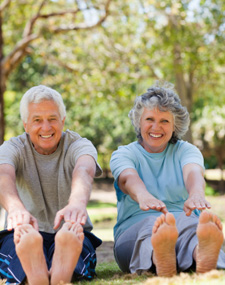 Here’s a test – how low can you squat, with your heels flat on the floor? We mean truly squat, with your behind parallel to, if not lower than, your knees.
Here’s a test – how low can you squat, with your heels flat on the floor? We mean truly squat, with your behind parallel to, if not lower than, your knees.
Can you even get down there without tipping over?
It’s tough, much tougher than squatting with your heels off the floor and weight resting on the balls of your feet. Stiff ankles and calves and tight hip flexors can all be to blame.
Being able to achieve that deep squat isn’t just for bragging rights – it can be an indicator of your health. Lacking this mobility puts you at a greater risk of hip disease, low back pain, or problems with the discs in your spine.
As we get older, we tend to lose mobility. We’re not as limber as we used to be. Getting up from the floor becomes more challenging. The answer isn’t to just resign yourself to it and say “well, I am getting older.”
We advocate mobility training, to stretch and adapt all the soft tissues in your body – muscle, tendon, fascia. It’s a great way to maintain good spinal and joint health, and regain the range of motion that will allow you to enjoy life and your favourite activities pain-free, and with less risk of injury.
If soft tissue in one part of your body is stiff, your body might compensate by moving in a different way that puts strain somewhere else. For example, you may think you have bad knees, but a stiff knee could in fact indicate a problem in your hip flexor which you can address in under a minute with the right stretch.
While regular cardiovascular exercise and weight training are important for your heart, bones, and joint health, don’t overlook the importance of stretching and foam rolling.
![]()
Stretch your hips
There are many different options. Here are a few:
Butterfly stretch: This is the classic. Sit on the floor with back straight and core tight. Pull your heels toward your groin with your hands on your feet, and push your knees down to the floor with your forearms. Hold for 20-30 seconds, then repeat.
Half-kneeling hip flexor stretch: Get down on the floor with right knee on the floor (you might want to use a small pillow) and your left knee up in front with foot flat on the floor. Keep your back straight and contract your core by sucking in your belly button. Raise your left arm straight over your head. Lean forward, letting your left knee push forward. Keep your back straight and core tight. Hold the stretch for 20-30 seconds. Repeat with the other side.
For a more advanced stretch, instead of raising that left arm over your head, reach back and pull your left foot off the floor. Again, focus on keeping the back straight and core tight. Then repeat on the right side.
![]()
Stretch your ankles and calves
The basics: Hang your foot over the edge of the bed or an ottoman. Bend your foot forward and back as far as you can about 20 times. Rotate your foot 10 times left, then 10 times right. Repeat and do the other foot.
Dorsiflexion stretch with towel: Now we’re going to nail those calf muscles and that Achilles tendon more directly. Sit with your leg straight out in front of you. Loop a towel or resistance band around the ball of your foot. Keep your back straight, pull the towel or band back toward you while pointing your toes toward your head. You will feel the stretch in the back of your leg. Hold for 20-30 seconds, repeat and do the other leg.
Roll those calf muscles: Using a foam roller can be more effective than just stretching to get the blood flowing and relax knotted muscles. Place a roller under one leg in the middle of the calf. Repeatedly roll from the ankle to just below the knee, and rotate the leg in and then out. If there is a spot that hurts, that’s a knot – that’s where you need to focus your effort. For more intense therapy, rest your other leg on top of the leg you are rolling. Another option for deeper tissue stimulation is to roll the calf over a barbell.
![]()
The rest of you
What else can you roll? Just about everything, when it comes to working out knots and achieving greater mobility – your buttocks by sitting on the roller, favouring one side then the other, your hamstrings the same way as your calves, and the quadriceps on top of your thigh by flipping around onto your stomach.
Don’t forget your chest: Most people who spend long hours over a desk end up with tight chest and front shoulder muscles that leads them to hunch their shoulders forward and slouch. This leads to the kinds of upper spine and neck problems that bring patients to a Chiropractor.
You can do this in a doorway. Stick your left arm straight out beside you, then bend the elbow to 90 degrees. Press your forearm and hand flat against the doorframe. Keep your back straight. Shift your left foot forward and twist your body slowly to the right until you feel that stretch in your left shoulder and chest. Hold for 20-30 seconds, repeat, and do the other side.

Jun 27, 2016 at 12:40 PM
These are great! Thank you.
Jun 28, 2016 at 6:31 PM
Thanks great information just what I need, more stretching and rolling is never too much. Thanks. Keep up the good work.